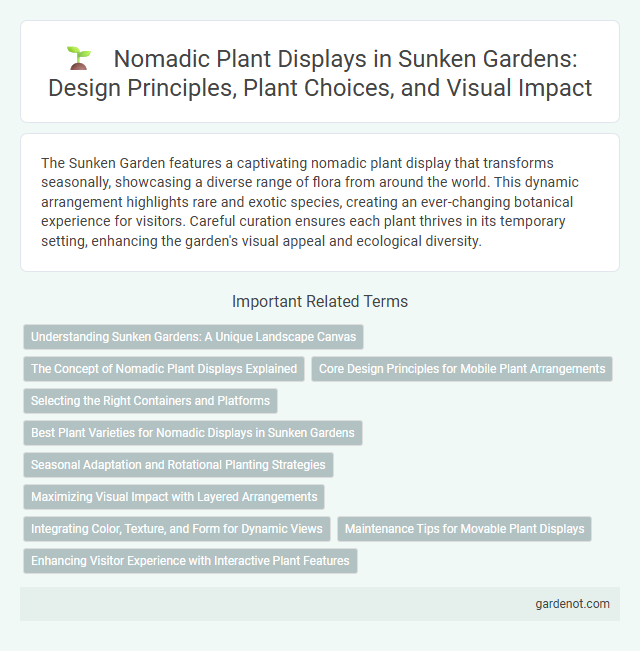The Sunken Garden features a captivating nomadic plant display that transforms seasonally, showcasing a diverse range of flora from around the world. This dynamic arrangement highlights rare and exotic species, creating an ever-changing botanical experience for visitors. Careful curation ensures each plant thrives in its temporary setting, enhancing the garden's visual appeal and ecological diversity.
Understanding Sunken Gardens: A Unique Landscape Canvas
Nomadic plant displays in Sunken Gardens transform these unique landscape canvases by introducing dynamic, seasonal vegetation that adapts to the sunken topology and microclimate. This approach emphasizes biodiversity, allowing diverse plant species to thrive in controlled, water-retentive soil environments characteristic of sunken gardens. Understanding how these movable displays interact with the garden's structural features enhances sustainable horticultural practices and aesthetic versatility.
The Concept of Nomadic Plant Displays Explained
Nomadic plant displays transform traditional gardening by showcasing plants in portable, adaptable arrangements that emphasize mobility and seasonal variety. These installations allow for dynamic interaction with diverse environments, blending horticulture with contemporary design principles. By prioritizing flexibility and spatial experimentation, nomadic plant displays redefine public and private garden experiences.
Core Design Principles for Mobile Plant Arrangements
Nomadic plant displays in sunken gardens emphasize flexibility, lightweight materials, and modular components to enable easy relocation and adaptation to varying environmental conditions. Core design principles focus on optimizing root aeration, water efficiency, and maximizing natural light exposure to support healthy mobile plant growth. Strategic layering and the use of compact, drought-tolerant species enhance ecological balance while maintaining aesthetic appeal in dynamic garden settings.
Selecting the Right Containers and Platforms
Choosing the right containers for a nomadic plant display in a sunken garden involves prioritizing lightweight, durable materials such as fiberglass or resin to facilitate easy mobility and weather resistance. Platforms should be sturdy and adjustable, ideally made from corrosion-resistant metals or treated wood, ensuring stability on uneven surfaces and enhancing the visual impact of the plant arrangements. Proper container drainage and platform ventilation further support plant health while maintaining the garden's aesthetic appeal.
Best Plant Varieties for Nomadic Displays in Sunken Gardens
Ideal plant varieties for nomadic displays in sunken gardens include shade-tolerant ferns, vibrant begonias, and trailing ivy species that thrive in partial sunlight and retain moisture well. Hardy succulents like sempervivums and echeverias provide low-maintenance texture contrast, while seasonal annuals such as impatiens and calibrachoa add bursts of color during warmer months. Selecting drought-resistant and compact plants ensures adaptability to temporary arrangements and varying microclimates within the garden's recessed environment.
Seasonal Adaptation and Rotational Planting Strategies
Nomadic plant displays in Sunken Gardens utilize seasonal adaptation by selecting species that thrive in specific climatic conditions, ensuring vibrant growth throughout the year. Rotational planting strategies enhance soil health and prevent pest buildup by alternating plant families and functional groups across growing seasons. This dynamic approach maximizes biodiversity, supports pollinators, and maintains visual interest with ever-changing floral compositions.
Maximizing Visual Impact with Layered Arrangements
Nomadic plant displays in sunken gardens maximize visual impact through layered arrangements that create depth and dynamic textures. By strategically positioning tall, medium, and low-height plants in tiers, designers enhance the garden's three-dimensional appeal and invite exploration from multiple viewpoints. This technique emphasizes color contrasts and foliage diversity, ensuring a captivating and immersive horticultural experience.
Integrating Color, Texture, and Form for Dynamic Views
Nomadic plant displays in sunken gardens utilize a diverse palette of colors, varied textures, and distinctive forms to create visually dynamic compositions that change with perspective and season. Strategic placement of vibrant foliage alongside sculptural shapes enhances depth and interest, encouraging visitors to explore multiple vantage points. Layering plants with contrasting hues and tactile surfaces fosters an immersive sensory experience that highlights the garden's evolving beauty.
Maintenance Tips for Movable Plant Displays
Nomadic plant displays in sunken gardens require regular watering schedules tailored to the specific needs of each species to prevent root rot and dehydration. Using lightweight, portable containers with proper drainage ensures ease of movement and healthy plant growth. Routine inspections for pests and nutrient replenishment through balanced fertilizers promote vibrant, sustainable displays.
Enhancing Visitor Experience with Interactive Plant Features
The nomadic plant display in the Sunken Garden integrates interactive features such as touch-sensitive foliage and augmented reality labels to engage visitors actively. These dynamic elements foster a deeper connection with diverse plant species by providing real-time information and sensory interaction. Enhancing visitor experience through technology-driven botanical exploration encourages education and appreciation of plant biodiversity.
Nomadic plant display Infographic

 gardenot.com
gardenot.com